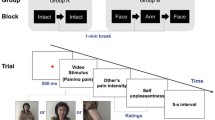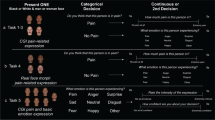Abstract
This article reviews recent theory and research on the origins, nature, and meaning of facial expressions of pain. A general model of pain expression, distinguishing experiential, encoding, and decoding processes involved in pain episodes, is proposed. Variables which are known to or may affect these processes are reviewed. Relationships between elements of the model and clinical phenomena of interest to health-care workers are discussed. The implications of findings in this area for health-care workers are examined. Areas in need of research are identified.
Similar content being viewed by others
References
Anand, K. J. S., & Hickey, P. R. (1992). Halothane-morphine compared with high-dose sufentanil for anesthesia and postoperative analgesia in neonatal cardiac surgery.New England Journal of Medicine, 326, 1–9.
Boucher, J. D. (1969). Facial displays of fear, sadness and pain.Perceptual and Motor Skills, 28, 239–242.
Craig, K. D. (1986). Social modeling influences: Pain in context. In R. A. Sternbach (Ed.),The psychology of pain (2nd ed.) (pp. 67–96). New York: Raven Press.
Craig, K. D. (1992). The facial expression of pain: Better than a thousand words?American Pain Society Journal, 1, 153–162.
Craig, K. D. (1994). Emotional aspects of pain. In P. D. Wall & R. Melzack (Eds.),Textbook of pain (3rd ed.) (pp. 261–274). Edinburgh: Churchill Livingstone.
Craig, K. D., & Grunau, R. V. E. (1993). Neonatal pain perception and behavioral measurement. In K. J. S. Anand & P. J. McGrath (Eds.),Neonatal pain and distress (pp. 67–105). Amsterdam: Elsevier.
Craig, K. D., Grunau, R. V. E., & Aquan-Assee, J. (1988). Judgment of pain in newborns: Facial activity and cry as determinants.Canadian Journal of Behavioural Science, 20, 442–451.
Craig, K. D., Hadjistavropoulos, H. D., Grunau, R. V. E., & Whitfield, M. F. (1994). A comparison of two measures of facial activity during pain in the newborn child.Journal of Pediatric Psychology, 19, 305–318.
Craig, K. D., Hyde, S. A., & Patrick, C. J. (1991). Genuine, suppressed, and faked facial behavior during exacerbation of chronic low back pain.Pain, 46, 161–172.
Craig, K. D., & Patrick, C. J. (1985). Facial expression during induced pain.Journal of Personality and Social Psychology, 44, 1080–1091.
Craig, K. D., Prkachin, K. M., & Grunau, R. V. E. (1992). The facial expression of pain. In D. C. Turk & R. Melzack (Eds.),Handbook of pain assessment (pp. 255–274). New York: Guilford.
Craig, K. D., Whitfield, M. F., Grunau, R. V. E., Linton, J., & Hadjistavropoulos, H. (1993). Pain in the pre-term neonate: behavioural and physiological indices.Pain, 52, 287–299.
Craig, K. D., & Wyckoff, M. G. (1987). Cultural factors in chronic pain management. In G. D. Burrows, D. Elton, & G. Stanley (Eds.),Handbook of chronic pain management (pp. 99–108). Amsterdam: Elsevier.
Ekman, P. (1977). Biological and cultural contributions to body and facial movement. In J. Blacking (Ed.),The anthropology of the body (pp. 38–84). London: Academic.
Ekman, P. (1984). Expression and the nature of emotion. In K. R. Scherer & P. Ekman (Eds.),Approaches to emotion (pp. 319–343). Hillsdale, NJ: Erlbaum.
Ekman, P., & Friesen, W. (1969a). The repertoire of nonverbal behavior: Categories, origins, usage and coding.Semiotica, 1, 49–98.
Ekman, P., & Friesen, W. V. (1969b). Nonverbal leakage and clues to deception.Psychiatry, 32, 88–105.
Ekman, P., & Friesen, W. (1975).Unmasking the face. Englewood Cliffs, NJ: Prentice-Hall.
Ekman, P., & Friesen, W. V. (1978).The Facial Action Coding System. Palo Alto, CA: Consulting Psychologists Press.
Ekman, P., & O'Sullivan, M. (1991). Who can catch a liar?American Psychologist, 9, 913–920.
Grunau, R. V. E., & Craig, K. D. (1987). Pain expression in neonates: Facial action and cry.Pain, 28, 395–410.
Grunau, R. V. E., & Craig, K. D. (1990). Facial activity as a measure of neonatal pain perception. In D. C. Tyler & E. J. Krane (Eds.),Advances in pain research and therapy.Proceedings of the 1st International Symposium on Pediatric Pain (pp. 147–155). New York: Raven.
Grunau, R. V. E., Johnston, C. C., & Craig, K. D. (1990). Neonatal facial and cry responses to invasive and noninvasive procedures.Pain, 42, 295–305.
Hadjistavropoulos, H. D., & Craig, K. D. (1994). Acute and chronic low back pain: Cognitive, affective and behavioral dimensions,Journal of Consulting and Clinical Psychology, 62, 341–349.
Hadjistavropoulos, H. D., Craig, K. D., Grunau, R. V. E., & Johnston, C. C. (1994). Judging pain in newborns: Facial and cry determinants,Journal of Pediatric Psychology, 19, 485–491.
Hadjistavropoulos H. D., Ross, M., & Von Baeyer, C. (1990). Are physicians' ratings of pain affected by patients' physical attractiveness?Social Science & Medicine, 31, 69–72.
Hadjistavropoulos, T., & Craig, K. D. (1994).Pain assessment in the cognitively impaired. Unpublished manuscript.
Hadjistavropoulos, T., McMurtry, B., & Craig, K. D. (in press). Beautiful faces in pain: Biases and accuracy in the perception of pain.Psychology and Health.
Johnston, C. C., Stevens, B., Craig, K. D., & Grunau, R. V. E. (1993). Developmental changes in pain expression in premature, full-term, two- and four-month-old infants.Pain, 52, 201–208.
Keefe, F. J., & Dunsmore, J. (1992). Pain behavior: Concepts and controversies.American Pain Society Journal, 1, 92–100.
Landers, J. (1990). Clinical judgments in pain management.Pain, 42, 15–22.
LeResche, L. (1982). Facial expression in pain: A study of candid photographs.Journal of Nonverbal Behavior, 7, 46–56.
LeResche, L., & Dworkin, S. F. (1988). Facial expressions of pain and emotions in chronic TMD patients.Pain, 35, 71–78.
LeResche, L., Dworkin, S. F., Wilson, L., & Ehrlich, K. J. (1992). Effect of temporomandibular disorder pain duration on facial expressions and verbal report of pain.Pain, 51, 289–296.
Patrick, C. J., Craig, K. D., & Prkachin, K. M. (1986). Observer judgments of acute pain: Facial action determinants.Journal of Personality and Social Psychology, 50, 1291–1298.
Poole, G. D., & Craig, K. D. (1992). Judgments of genuine, suppressed and faked facial expressions of pain.Journal of Personality and Social Psychology, 63, 797–805.
Prkachin, K. M. (1986). Pain behavior is not unitary.The Behavioral and Brain Sciences, 9, 754–755.
Prkachin, K. M. (1992a). The consistency of facial expressions of pain: A comparison across modalities.Pain, 51, 297–306.
Prkachin, K. M. (1992b). Dissociating spontaneous and deliberate expressions of pain: Signal detection analyses.Pain, 51, 57–65.
Prkachin, K. M., Berzins, S., & Mercer, S. R. (1994). Encoding and decoding of pain expressions: A judgment study.Pain, 58, 253–260.
Prkachin, K. M., & Mercer, S. R. (1989). Pain expression in patients with shoulder pathology: Validity, properties and relationship to sickness impact.Pain, 39, 257–265.
Prkachin, K. M., Solomon, P. S., Hwang, T. & Mercer, S. R. (1995). Does experience affect judgements of pain behaviour?: Evidence from relatives of pain patients and health-care providers. Manuscript submitted for publication.
Rinn, W. E. (1984). The neuropsychology of facial expression: A review of the neurological and psychological mechanisms for producing facial expressions.Psychological Bulletin, 95, 52–77.
Rosenthal, R. (1982). Conducting judgment studies. In K. Scherer and P. Ekman (Eds.),Handbook of methods in nonverbal behavior research (pp. 287–361). New York: Cambridge University Press.
Scott, C. S., Riggs, K. W., Ling, E., Solimano, A., Fitzgerald, C., Hill, M., Grunau, R. V. E., & Craig, K. D. (1994).Morphine pharmacokinetics and pain assessment in premature newborns. Manuscript in preparation.
Tomkins, S. S. (1962).Affect, imagery and consciousness. Vol. 1. New York: Springer.
Von Baeyer, C. L., Johnson, M. E., & McMillan, M. J. (1984). Consequences of nonverbal expression of pain: Patient distress and observer concern.Social Science & Medicine, 19, 1319–1324.
Von Korff, M., Dworkin, S. F., & LeResche, L. (1990). Graded chronic pain status: An epidemiologic evaluation.Pain, 40, 279–292.
Wall, P. D., & Melzack, R. (Eds.). (1994).Textbook of pain, (3rd ed.). Edinburgh: Churchill Livingstone.
Wilkie, D. J. (1995). Facial expressions of pain in lung cancer.Analgesia, 1, 91–99.
Author information
Authors and Affiliations
Additional information
The authors' research reported in this paper was supported by research grants to K. M. Prkachin from the Medical Research Council of Canada and to K. D. Craig from the Social Sciences and Humanities Research Council, the Natural Sciences and Engineering Research Council, the Medical Research Council, and the British Columbia Health Care Research Foundation. We gratefully acknowledge the helpful comments on earlier drafts of Mark Costanzo, Sherry Beaumont, Linda LeResche, and Glenda Prkachin, and the issue editor, Val Derlega.
Rights and permissions
About this article
Cite this article
Prkachin, K.M., Craig, K.D. Expressing pain: The communication and interpretation of facial pain signals. J Nonverbal Behav 19, 191–205 (1995). https://doi.org/10.1007/BF02173080
Issue Date:
DOI: https://doi.org/10.1007/BF02173080




